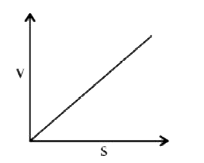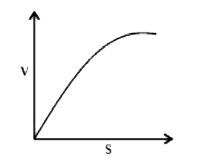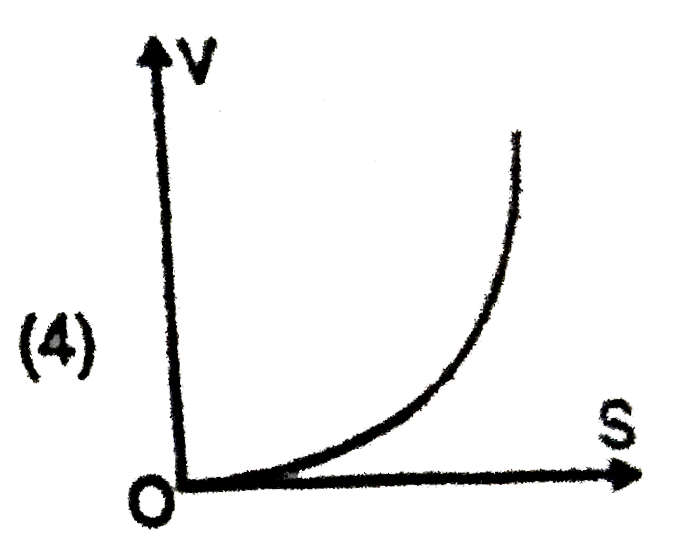A particle starts moving in a straight from rest with constant acceleration until it reaches velocity v. The distance travelled by it until this point is . Then, it covers a further distance x at constant velocity. Finally, it slows down to rest at a constant rate such that it covers distance 2x. The total time for which the particle moved is T .Then ,Tvx=
To solve the problem step by step, we will break down the motion of the particle into three distinct phases:
1. Acceleration Phase (from rest to velocity v)
2. Constant Velocity Phase (moving with velocity v)
3. Deceleration Phase (slowing down to rest)
Step 1: Acceleration Phase
The particle starts from rest and accelerates to a velocity v with a constant acceleration a.
Using the first equation of motion:
v=u+at
Since the initial velocity u=0:
v=at1
Thus, the time taken to reach velocity v is:
t1=va
Now, using the second equation of motion to find the distance x traveled during this phase:
x=ut1+12at21
Substituting u=0:
x=12at21
Substituting t1=va:
x=12a(va)2=v22a
Step 2: Constant Velocity Phase
In this phase, the particle moves a further distance x at constant velocity v.
The time taken t2 to cover this distance is given by:
t2=xv
Step 3: Deceleration Phase
In this phase, the particle decelerates to rest covering a distance of 2x. Let the deceleration be a′.
Using the first equation of motion:
0=v−a′t3
Thus:
t3=va′
Using the second equation of motion for the distance covered:
2x=vt3−12a′t23
Substituting t3=va′:
2x=v(va′)−12a′(va′)2
This simplifies to:
2x=v2a′−12v2a′=v22a′
Thus:
2x=v22a′
From this, we can find a′:
a′=v24x
Total Time Calculation
Now we can calculate the total time T:
T=t1+t2+t3
Substituting the values:
T=va+xv+va′
Substituting a′=v24x:
T=va+xv+4xv=va+5xv
Finding the Ratio Tvx
Now, we need to find Tvx:
Tvx=v2ax+5
From the earlier relationship x=v22a:
Thus:
Tvx=v2v22+5=2+5=7
Final Answer
Therefore, the final result is:
Tvx=7
2. Constant Velocity Phase (moving with velocity v)
3. Deceleration Phase (slowing down to rest)
The particle starts from rest and accelerates to a velocity v with a constant acceleration a.
v=u+at
Since the initial velocity u=0:
v=at1
Thus, the time taken to reach velocity v is:
t1=va
x=ut1+12at21
Substituting u=0:
x=12at21
Substituting t1=va:
x=12a(va)2=v22a
In this phase, the particle moves a further distance x at constant velocity v.
t2=xv
In this phase, the particle decelerates to rest covering a distance of 2x. Let the deceleration be a′.
0=v−a′t3
Thus:
t3=va′
2x=vt3−12a′t23
Substituting t3=va′:
2x=v(va′)−12a′(va′)2
This simplifies to:
2x=v2a′−12v2a′=v22a′
Thus:
2x=v22a′
From this, we can find a′:
a′=v24x
Now we can calculate the total time T:
T=t1+t2+t3
Substituting the values:
T=va+xv+va′
Substituting a′=v24x:
T=va+xv+4xv=va+5xv
Now, we need to find Tvx:
Tvx=v2ax+5
From the earlier relationship x=v22a:
Thus:
Tvx=v2v22+5=2+5=7
Therefore, the final result is:
Tvx=7
Similar Questions
A particle starts moving from position of rest under a constant acceleration if it travels a distance x in t second, what distance will it travel in next t second?
View SolutionA particle starts moving from the position of rest under a constant acc. If it travels a distance x in t sec, what distance will it travel in next t sec ?
View Solution
Knowledge Check
A particle, initially at rest, starts moving in a straight line with an acceleration a=6t+4m/s2. The distance covered by it in 3 s is
A15 mB30 mC45 mD60 mA particle starts from rest and moves with constant acceleration. Then velocity displacement curve is:
A B
B C
C D
D
A particle starting from rest moves along a straight line with constant acceleration for this velocity displacement graph will have the form-
A B
B C
C D
D
A car starts from rest and moves with constant acceleration. In first t seconds it covers distance x. Then distance covered by it in next t seconds will be:-
View SolutionA particle starts moving from rest under a constant acceleration. It travels a distance x in the first 10 sec and distance y in the next 10 sec, then
View SolutionA particle at rest starts moving in a horizontal straight line with a uniform acceleration. The ratio of the distances covered during the fourth and third seconds is
View SolutionA body starting from rest moves with constant acceleration. The ratio of distance covered by the body during the 5th sec to that covered in 5 sec is
View SolutionA body moving in a straight line with constant acceleration covers distances a and b in successive equal time interval of t. The acceleration of the body is
View Solution
